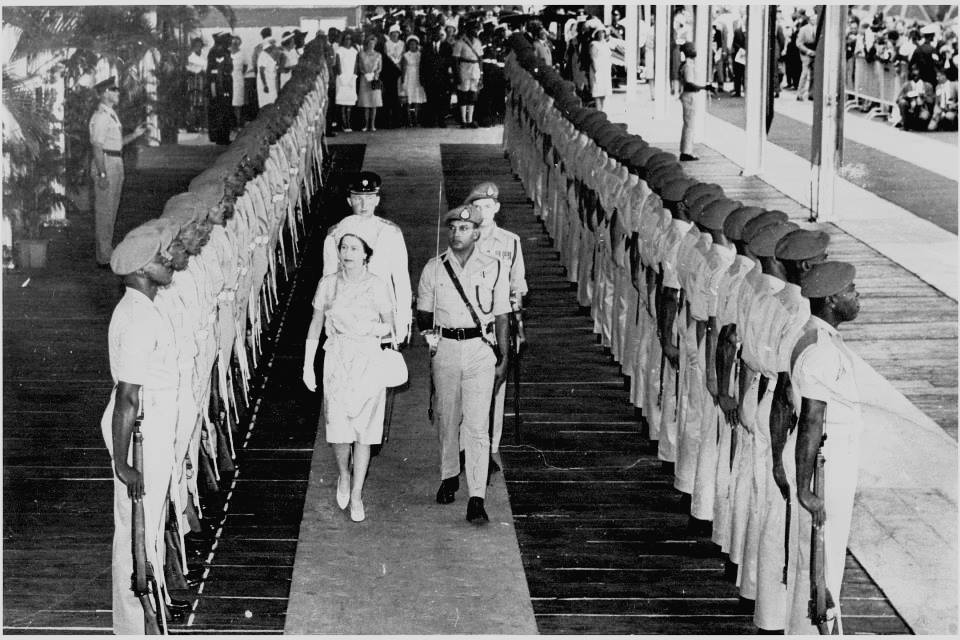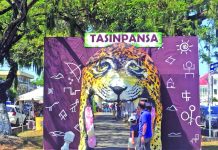>>> A then 20-year-old reporter Claudette Earle, now a retired newspaper editor, pens her firsthand experience of the festivities during HRH Queen Elizabeth’s visit in the monumental year of 1966 just prior to Guyana gaining independence. With her permission, Guyana Times Sunday Magazine reprints a now historic event. <<<
“The little child and his mother were among the hundreds who had walked miles down the East Bank road before 7 o’clock that morning in order to secure positions of vantage along the streets the queen was scheduled to pass. They had stood behind the police cordon for more than 90 minutes. They presented a lively picture of colour in their bright holiday attire. The morning was warm, and dozens of multi-coloured umbrellas brought slight respite from the increasing heat.
Guyanese were in a state of suppressed excitement for this was the first time a reigning sovereign had deigned to visit this country.
Seasoned with long waiting, the people suddenly heard the muffled roar of the outriders’ motor cycles, and they strained their necks to see her as she came into sight, seemingly gliding by in the Austin Princess.
To the hundreds of Guyanese assembled so orderly on the streets, she was all they had read about and much more. Her complexion was an exceptional asset, and her deportment, though regal, was void of haughtiness. Fetchingly attired in a day dress of jade and primrose yellow with a fluffy white hat, she had alighted earlier from the plush luxury of the Royal Yacht Britannia on to the solid greenheart wharf of Sproston’s to begin a two-day tour of the country.



Guyana was the first stop of her Caribbean itinerary and, significantly enough, 1966 was the year of our Independence which occurred four months after her visit. Many felt that her royal presence in this country was England’s manner of making a tacit and graceful seal to the 152 years of colonial rule of British Guiana– a grand exit to the old era.
It was also a time of searching and preparation for the average native, for at that time Guyanese were being urged to assume the independence of spirit. And if the visit was meant to be goodbye, we could not have excelled ourselves.
Indeed, the 40-year-old sovereign actually voiced our thoughts and aspirations when, in replying to the Prime Minister’s speech of welcome on the balcony of Parliament Building, she exhorted us: “Now is time to look forward with hope and resolution that all of this land, of whatever ancestry or creed, shall enjoy a shared prosperity and happiness as citizens of Guyana.”
Eclipsed only by the independence celebrations, which was the event of the year, Queen Elizabeth’s visit was a most momentous national event in the country. Day and night, wherever she travelled, the streets were heavily lined with people all eager to cheer tumultuously. They came not only from Georgetown and its suburbs, but from the sprawling coastal belt and the far-flung areas in the hinterland.
For days prior to the visit, the city has assumed a gay and holiday appearance. Thousands of multi-coloured bulbs traced sparklingly the definitions of business places at night, while during the day, flags and buntings in a riot of colours fluttered noisily in the breeze.
The Guyanese government had proclaimed Friday, February 2 a holiday in honour of the visit, enabling thousands of the working population the opportunity of seeing the sovereign. And, true to Guyanese style, she was accorded a fantastic and thoroughly warm-hearted welcome. Waiting to greet her were Governor Sir Richard and Lady Luyt, Prime Minister Mr Forbes Burnham, and the Chief Justice Sir Joseph Luckhoo. After replying to the speech by the prime minister she visited the emblematically ornate and sombre chamber of the house.
The queen was welcomed by the speaker, Mr. A. P. Alleyne, after which she and Prince Phillip unveiled full-length portraits of themselves, each on either side of the speaker’s chair. Thence the royal party glided slowly through the lined streets to the civic reception at the Promenade Gardens where a section of Georgetown’s citizens waited.
Coolly confident of carriage, and grateful of person, the queen met and chatted lightly with councillors both of the Georgetown and New Amsterdam Town Councils. Her sincere interest never lags in the face of any pressure of exhaustion. This commendable aspect of her personality was unfolded before the curious and wondering eyes of the public during her brief stay. She always appeared fresh and interested in everything about her.
Later that day, when the sunshine was hottest, the queen – ardent racing fan that she is – was the cynosure of all eyes when she and her entourage attended the special meeting of the Demerara Turf Club at D’Urban Park. Thousands had borne the heat of the sun and were converged on the Park to see her. She rewarded them with friendly smiles and waves.
And yet her official engagements were not done for that day.
After knighting Sir Lionel Luckhoo at Guyana House during the afternoon, she boarded the yacht for a brief respite before leaving to attend the prime minister’s reception at The Residence.
On the way, she viewed Georgetown, now a fairy city. The beautifully illuminated Town Hall was the most outstanding of them all. The lofty edifice, with its tall spire, was studded with hundreds of white bulbs; here, it seemed to us, was a precious gem of gigantic proportions artistically cut and set in the heart of the city.
More than 2,000 people were entertained at the reception. And Queen Elizabeth, elaborately begowned and wearing a diamond tiara in her hair, heard for the first time the thrilling staccato rhythm of the masquerade band, while she gazed, and marvelled, at the tall lady on the stilts.
The night, bewitched with glitter and magic, presented a most suitable background for such an auspicious social function. Guyanese talent and culture in their varied forms impressed deeply all those present. Seven-year-old Pulmattie Gobin Ram proved herself to be an artist with remarkable promise a she danced her way into the hearts of all. Present also at the function was the 100-strong National Symphony Choir, and the Silvertones Steel Orchestra, which panned the story of “Uncle Joe”, while choreographer Pat Anderson led the Theatre Guild Dance Troupe in some exotic contortions.
If Friday’s schedule was considered tight, Saturday’s was even tighter. In the morning the queen attended the spectacular Children’s Rally which was without argument, the highlight of the festive activities surrounding the Royal visit.
Never before was such a display of channelled inborn grace and rhythm of the Guyanese given. A mass choir of 10,000 voices drawn from 32 schools in and around Georgetown told the stories in songs of “A Coloured Girl in the Ring”, “Bessie Down” and “Hear Auntie Bess”, accompanied by the skilful arrangements of the Police Force Band. And, in the while, these spirited little imps, 210 of them, cutely attired in short white dresses with coloured frilled panels matching the lovely hibiscus crowns on their heads, danced surely with perfect precision to the delight of the royal party. The queen leaned forward on her chair, her face mirroring pure rapture at the spectacular performance.
The popular Indian song, “Sohani Rhaat”, to which the girls danced beautifully in a slower tempo, was a wonderful example of cultural integration…the theme of the nation since. Other displays by the youths of Guyana followed, and songs in blessing of the queen were sung. Presentations to the queen by three children were made before the royal couple drove around the ground to acknowledge the tumultuous ovation of the children.
Then, in the dazzling heat of the approaching midday sun, Queen Elizabeth travelled up by railway coach eight miles to La Bonne Intention where she viewed a rural display. She was presented with a map of Guyana in gold. Dance groups, including comfa and masquerade bands, performed.
Later that afternoon she was again bound for another engagement, this time to open the Queen Elizabeth National Park on Thomas Lands. And it was an exceptionally fashionable turnout of Guyana’s fairer sex. They excelled themselves in the interpretation of current dress trends. Exquisite creations of chiffon, floral nylon fabrics, and embroidered linens, matched with absurdly fitted picture hats and impossible stiletto heeled shoes, made many men turn for a second glance. The queen herself looked charming in blue silk intricately cut to give a split level effect.
Her other immediate engagement was to open the Industrial Fair at the B.G.C.C. ground. So genuinely interested was she in the display of Guyana’s products that the spent 40 minutes more than her allotted touring time. And while a popular steel orchestra proposed “A unto Her Majesty” in calypso song styling, the queen visited the Amerindian village and evinced keen interest in the making of cassava bread and cotton spinning.
Thus ended the official visit of the sovereign. And, as the car finally conveyed the royal party to Sproston’s wharf, thousands of Guyanese, jam-packed behind the police cordons, strained their bodies in an effort to catch a last look.
“Captain, Captain put me ashore. I doan want to go anymore! Itanami gon drownded me…” caroused hundreds of Guyanese in mock-mournful tones while they swayed rhythmically to the slow tempo of this time-honoured folk song, bidding, as they sang, goodbye to the queen. Her Majesty stood on the deck of the Britannia, visibly affected by the compelling undercurrent of Wet Indian beat.
All the tension and strain of preparation for this brief tour were released in this gay free-for-all sing-song. In fact this was the culmination of the warmth of sincere Guyanese hospitality accorded their monarch.
Yes it was truly the most relaxed period of the visit. We were happy because everything –every event – had moved smoothly and efficiently. And, as we said goodbye, we tried to convey the message of our culture to the heart of the queen.
Fifty persons, including the governor and the prime minister, had been her guest for dinner. They all stood leaning against the rails, their faces alight with pleasure and excitement as they looked upon the swirling joy-makers. Drumming her fingers lightly on the rail, the queen kept time to the sultry interpretation of “Lilli Gal”, “Wata Wash a Sea”, and the farewell bidding “Goodnight aye, Good night O”.
And on this note the thrilling tour ended.
Guyana had done herself proud on the two days and had, indeed, showed the rest of the world what she was capable of doing with the utmost ease and grace.”











